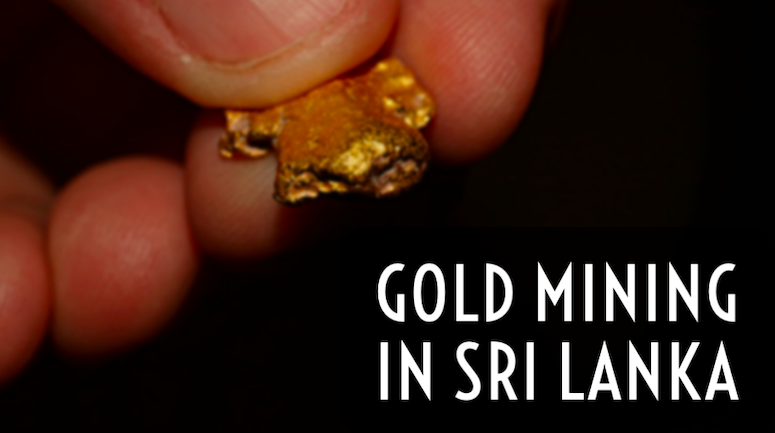
The island country of Sri Lanka is rich in natural beauty, culture, spices, and gold. The country might not have much to offer to large mining operators, but it has always interested small-scale artisanal miners who flock the island to try their luck.
For the past decade, gold has had a bullish run in the international market. Private investors and mining companies have taken note of this boom and renewed their interest in Sri Lankan gold. The government, on its part, has taken proactive steps to assist the private sector in revitalizing the waning mining industry.
Sri Lanka: A Land of Gold since Antiquity
The history of gold in the island nation dates back at least two thousand years ago. Ancient literature reveals that gold was excavated from the area near Acaraviyyagama during the reign of the Sinhalese King Dutugamunu in the 2nd Century BC. It’s said that miners could easily find gold nuggets of various sizes and weights.
Records from the 8th Century AD also reveal that gold was aplenty in Sri Lanka. The reports say that during Abeyagiri excavations a gold ingot, the largest at that time, was discovered.
Like in other places in the world, Sri Lanka witnessed its first major gold rush in the 1850s. It was a British seaman, Brandly who discovered gold dust in the late 1840s. He found gold near Colombo, in the Maha Oya stream. The news soon spread across the island and world, attracting fortune seekers in the thousands.
The hot and humid climate of Sri Lanka provided a favorable environment for the spread of many diseases. Soon, many gold prospectors became victims of fever. Frequent floods killed many and compounded the misery of the prospectors. Sri Lanka was a hard place to live during that time.
Kelaniya River: The New Playground for the Artisanal Miners
Over the centuries it has become known that gold deposits are scattered throughout the island. A couple of hundred years ago, the climate and terrain might not have been conducive for gold mining and prospecting. But with modern tools and equipment, gold prospecting is fast developing into an engaging activity. Many people living in Sri Lanka depend on alluvial mining for their income.
In recent times, the interest of the locals and artisanal miners increased due to the gold deposits in the Kelaniya River. Along the riverbeds and creeks near Colombo and throughout the country there has been a surge in mining and panning activity.
It’s believed that prospectors have found only a fraction of the alluvial gold in the rivers of Sri Lanka. In the coming years, expect more small scale and recreational miners to throng the riverbanks of Sri Lanka in search of gold.
Sri Lanka: Sitting on a Pile of Gold
Expert teams, who have been studying the country for years, have come up with reports that indicate the presence of large gold deposits in Sri Lanka. So far, Sri Lanka has seen only limited commercial mining. The country is rich in alluvial gold deposits that can be easily processed with simple and already available mining techniques.
These alluvial sources are more attractive to small-scale and medium-scale mine operators.
Many research groups are beginning to realize that Sri Lanka is a treasure trove of many valuable metals and minerals. Analyzing the sand samples taken from Deniyaya, the Gem and Jewelry Authority revealed the presence of gold, titanium, and uranium.
Geological survey reports of Nilwala Ganaga, Deniyaya, Akuressa, Horana have come to a similar conclusion of finding large deposits of gold in these areas.
Recently, the Sri Lankan authorities have also discovered gold near Walawe River and Manik River, and in Balangoda and Kiriibbanwewa. Studies show that gold deposits can also be found in the Southern and Central regions of the island.
Artisanal or small scale miners produce the lion’s share of gold in the island country. That’s because, in Sri Lanka, the bulk of the yellow metal is not deep under the earth, but in quartz reefs and alluvial deposits throughout the rivers.
Recommended Gear: 31″ Modular Sluice Box with Flare
The Future of the Gold Mining Industry in Sri Lanka
After surveying the areas around Seruwawila and Ambalantota, experts have found an area, measuring 10 by 250 miles, which is rich in minerals. Apart from gold, other metals and minerals such as cobalt, iron, copper, and magnetite are also found here. Many believe that these minerals will attract significant international interest in the years to come.
For decades, Sri Lanka’s bloody civil war was the biggest stumbling block for foreign investment and overall development. After its end, the government has considerably liberalized the investment policy, regulations, and tax structure to attract investment into its mining sector.
The island nation has large reserves of gold deposits that are yet to be mined. Of course Sri Lankan won’t have any problem selling its gold. Gold-hungry countries such as India (neighbor) and China (the largest investor) are always on the lookout for more gold to buy.
Sri Lanka is taking all the right steps and moving in the right direction. Soon, the island nation is quite likely to become a major gold producer.
